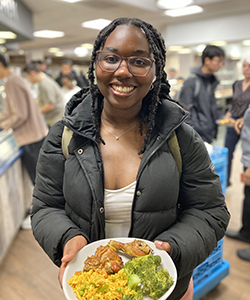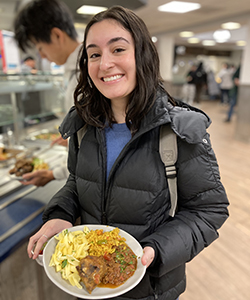NU Dining’s Black History Month menu celebrates culinary traditions in Black culture
Expanding the menu to reflect this rich diversity was a meaningful way to celebrate the broader contributions to Black history.”
Melissa McCullough
Director of Dining Services
Director of Dining Services Melissa McCullough talks inspiration, research behind the menu
NU Dining recognized Black History Month with a menu celebrating the diverse culinary traditions of Black culture, spearheaded by Director of Dining Services Melissa McCullough.
Each Tuesday during February, Northwestern’s dining halls served cuisines during lunch highlighting East African, West African and Caribbean, Afro-Latin or African American cuisine, to reflect the diverse influences that shape Black cuisine.
Keep reading to learn more about McCullough's inspiration behind the menu.
This interview has been lightly edited for brevity and clarity.
 Q: How did the idea for the Black History Month menu come about?
Q: How did the idea for the Black History Month menu come about?
A: When we think of Black History Month, the focus is often on African Americans and Black America. However,Black history is deeply influenced by individuals of African, Caribbean and Afro-Latin descent. Many of our staff associates and students identify with these backgrounds, and they were excited to see a more inclusive representation through this event. Expanding the menu to reflect this richdiversity was a meaningful way to celebrate the broader contributions to Black history.
Q: Can you tell us about the planning process behind selecting the dishes featured on the menu?
A: We collaborated closely with our culinary team and associates to thoughtfully curate a menu that highlighted different regional cuisines each week. While we included familiar favorites, we also made it a priority to introduce dishes that may be lesser known, offering students an opportunity to explore new flavors and culinary traditions. Authenticity was at the heart of our selections, and we paired each week’s menu with an educational component to provide historical and cultural context.
Ultimately, this process was about more than just food—it was about storytelling, education and celebrating the deep-rooted connections between culture and cuisine.
Q: What do you think is the significance of creating this Black History Month menu for the dining halls?

A: Working on campus, I witness the incredible diversity among both students and associates. It was important to create a space where their voices, histories and cultures are recognized and celebrated. This menu serves to not only share traditional flavors but also spark conversations.
Q: Which meal from this month were you most excited about?
A: I really enjoyed the Haitian Beef Stew and the stewed black-eyed peas. The many variations of rice, legumes, stews and starches that are characteristic to the areas we featured had regional condiment combinations and methods of preparation that we are not usually exposed to.
Q: What has the reception been from students so far?
A: Many students asked about the origins of the menus. It was a special way of engaging with both the associates who were making new meals they had never seen before, and students who got exposure or representation from this event.
